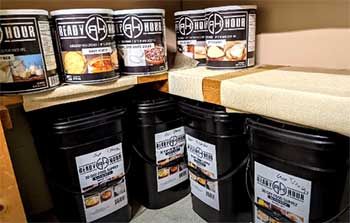If you’re in the market for a generator that is reliable, powerful, and versatile, the Predator 5000 generator might be on your radar. After extensive research and personal experience, I’ve found that the best place to purchase this product is Harbor Freight.
They frequently offer discounts and promotions that can make a real difference in price, and it’s a trusted retailer for tools and generators. Plus, their extended warranties provide peace of mind.
Whether you’re looking for a backup during power outages or something for your RV adventures, the Predator 5000 is worth considering. But how does it perform in real-world conditions?
Let’s go over my experience, the pros and cons, and how it stacks up against other brands.
My Experience With Predator 5000 Generator
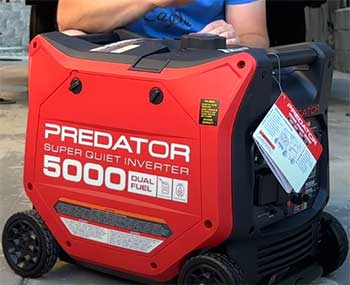
When I first got my hands on the Predator 5000, I was genuinely impressed. The generator felt sturdy and well-built.
It’s powered by a Predator 224cc engine that offers 5000 starting watts and 3900 running watts.
That’s more than enough power to run essential appliances during an outage, or an air conditioner and several smaller devices while camping.
One of the biggest selling points for me was the dual-fuel capability.
You can switch between gasoline and propane while it’s running, which is perfect when one fuel type runs low.
The electric start made it easy to power on without messing with manual choke systems, and the remote start option was just the icing on the cake. It’s convenient to be able to start or stop the generator from up to 100 feet away.
However, it’s not without some drawbacks. For instance, the proprietary LP gas connection might be a small inconvenience for RV owners, as it’s not compatible with the standard 1/4″ quick connect found on many RVs.
Pros of The Predator 5000 Generator
After using the Predator 5000 for several weeks, these are the standout features that I found truly beneficial:
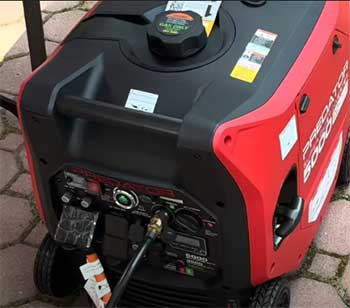
- Dual Fuel Capability: Switching between gasoline and propane without stopping the generator is a significant advantage. I found that while switching fuels, the generator would only sputter briefly when transitioning from gas to propane, and then it was back to normal operation. It’s very versatile, especially in an emergency situation where fuel availability might be unpredictable.
- Quiet Operation: This generator is marketed as super quiet, and I was initially skeptical, but after using it, I can confidently say it’s much quieter than other generators I’ve owned. At around 60.5 dBA, it’s still noticeable, but not obnoxious. It’s quiet enough that I was able to run it overnight without disturbing our sleep, which is crucial for camping trips.
- Easy to Move Around: Thanks to its telescoping handle and large flat-free wheels, moving the Predator 5000 around was a breeze. It’s heavy, weighing in at over 100 pounds, but the wheels make it manageable. I didn’t have to lift it at all, even when moving it over rough terrain.
- Pure Sine Wave Inverter Technology: I liked that the generator features pure sine wave inverter technology, which allows you to safely run sensitive electronics like laptops and smartphones. This made it perfect for our RV setup where we had laptops running alongside the AC and microwave.
- Safety Features: The CO Secure technology is a big plus, automatically shutting down the generator when unsafe carbon monoxide levels are detected. This adds an extra layer of safety when using it for extended periods or in semi-enclosed spaces.
Cons of The Predator 5000 Generator
While the Predator 5000 offers plenty of advantages, it’s not without its limitations. Here’s what I found:
- Proprietary LP Gas Connection: As mentioned earlier, the LP gas connection is proprietary, which could be a hassle if you plan on using it with your RV’s standard connections. While not a dealbreaker, I had to buy an adapter to make it compatible, which added a bit of frustration.
- Learning Curve with the Remote Start: The remote start feature is fantastic in theory, but I did experience a slight learning curve. You have to press the start button twice for it to activate. Once I figured that out, it worked like a charm, but I initially missed it in the manual.
- Maintenance: Although the generator is relatively easy to maintain, it does require regular upkeep, especially after the break-in period. Make sure to change the oil regularly and monitor fuel levels closely. I found that it ran smoother with premium gasoline, though it functions just fine with regular fuel.
Maintenance Tips For Long-Term Use
Maintaining the Predator 5000 generator is essential for its longevity. Here are some tips based on my experience:
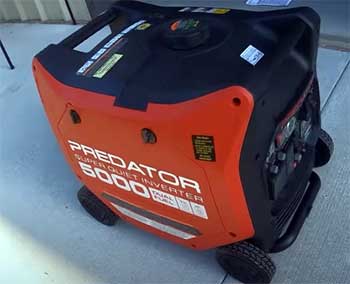
- Change the Oil Regularly: After the initial break-in period, change the oil after the first 20-30 hours of use. After that, it’s best to change the oil every 100 hours or as recommended in the manual. I found that using synthetic oil helped improve the engine’s performance.
- Check the Fuel and Air Filters: Keeping the fuel and air filters clean is crucial. A clogged filter will make the generator run inefficiently and could lead to damage over time.
- Run the Generator Regularly: Don’t let the generator sit idle for long periods. Even if you’re not using it, running it for 10-15 minutes every couple of weeks will keep it in good shape.
- Use Fuel Stabilizer: If you’re planning to store the generator for extended periods, add a fuel stabilizer to the gasoline tank. This will prevent the fuel from degrading and clogging the carburetor.
- Monitor the CO Secure Shutdown: Ensure that the CO Secure feature is functioning properly by running tests in a well-ventilated area. It’s better to be safe than sorry, especially when using it in enclosed or semi-enclosed spaces.
Comparing Predator 5000 With Other Brands
- Predator 5000 Vs. Predator 4550 Inverter Generator
If you’re loyal to the Predator brand, the Predator 4550 Inverter Generator is another option you might consider. While both are solid choices, they serve slightly different needs.

The Predator 4550 is lighter and more portable, weighing in at about 100 pounds with a lower wattage output of 4550 starting watts and 3650 running watts.
This makes it ideal for those who need something more compact and manageable, such as for tailgating, small camping trips, or minimal backup power during an outage.
However, if you need more power to run heavier appliances like air conditioners or multiple devices simultaneously, the Predator 5000 is the better choice with its 5000 starting watts and 3900 running watts.
Both models are quiet, but the Predator 4550 is slightly quieter due to its smaller engine, operating at around 57 dBA compared to the Predator 5000’s 60.5 dBA.
However, in terms of overall versatility, the Predator 5000 wins out with its dual-fuel capability and higher wattage for more demanding needs.
- Predator 5000 Vs. GENMAX 5500-Watt Generator
The GENMAX 5500-Watt Generator is another powerful contender in the same range as the Predator 5000, offering 5500 starting watts and 5000 running watts.
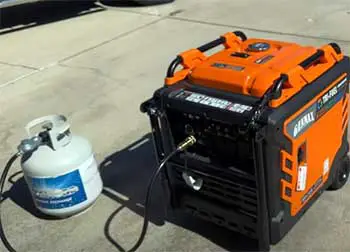
Like the Predator 5000, the GENMAX also has dual-fuel capability, which makes it a strong competitor.
Both are relatively quiet, but I found the Predator 5000 to have a slight edge when it comes to noise level, especially during extended use in quiet environments like campgrounds.
One area where the GENMAX pulls ahead is in portability.
It’s slightly lighter than the Predator 5000, making it easier to transport, though the Predator 5000’s larger flat-free wheels and telescoping handle make it quite mobile, too.
In terms of price, the GENMAX typically costs a bit more due to its premium features, but the Predator 5000 offers better value for most people, especially those who don’t need the full 5500 watts.
For everyday users or RV enthusiasts, the Predator 5000 is the more budget-friendly, reliable option.
- Predator 5000 Vs. Powermate 7500 Generator
The Powermate 7500 Generator sits in a higher wattage category, boasting 7500 starting watts and 6000 running watts.
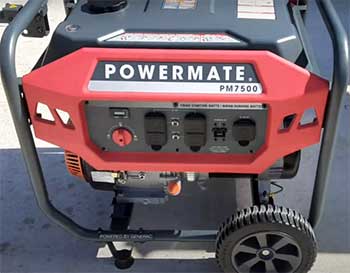
This is significantly more power than the Predator 5000, making it a good option if you’re looking to run a whole house during a power outage or if you need to power large appliances like central air conditioning alongside other electronics.
However, with that extra power comes additional weight and noise.
The Powermate 7500 is much heavier, making portability a challenge if you need something to move around frequently, such as for RV trips or outdoor events.
Additionally, the noise level is noticeably higher than the Predator 5000, making it less ideal for environments where noise is a concern.
In terms of price, the Powermate 7500 tends to be significantly more expensive than the Predator 5000. If you’re not in need of such a high power output, the Predator 5000 offers a better balance of portability, noise level, and fuel efficiency for most users.
The Predator 5000’s dual-fuel capability also adds a layer of versatility that the Powermate 7500 doesn’t match.
Frequently Asked Questions (FAQ)
The Predator 5000 is built to last with proper maintenance. If you keep up with oil changes, air filter cleanings, and regular use, you can expect this generator to last for several years—potentially up to 10 years or more.
Yes, for a generator of its size and power, the Predator 5000 is considered super quiet. At around 60.5 dBA, it’s quieter than many other generators in its class. You can easily hold a conversation near it without needing to raise your voice.
No, Predator generators are not made by Honda. While they share some similarities in terms of engine design and build quality, Predator is a separate brand sold primarily through Harbor Freight.
A 5000-watt generator can run most essential household appliances during a power outage, but it may not power everything at once. It’s enough to run your refrigerator, lights, and some smaller appliances. However, if you want to power larger systems like central air conditioning, you may need a generator with a higher wattage or use it selectively to manage your energy use.
Conclusion: Is The Predator 5000 Worth It?
In my experience, the Predator 5000 is a great value for its price. Its dual-fuel capability, quiet operation, and ease of use make it perfect for RVing, camping, or as a home backup generator.
While it has some minor flaws like the proprietary LP gas connection, they’re easily outweighed by its benefits.
If you’re looking for a reliable, powerful generator without breaking the bank, I highly recommend purchasing the Predator 5000 from Harbor Freight.
With its versatile fuel options and quiet operation, it’s a solid choice for anyone needing a generator that delivers dependable performance.

